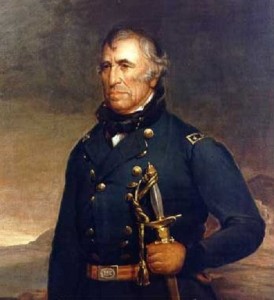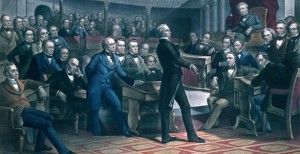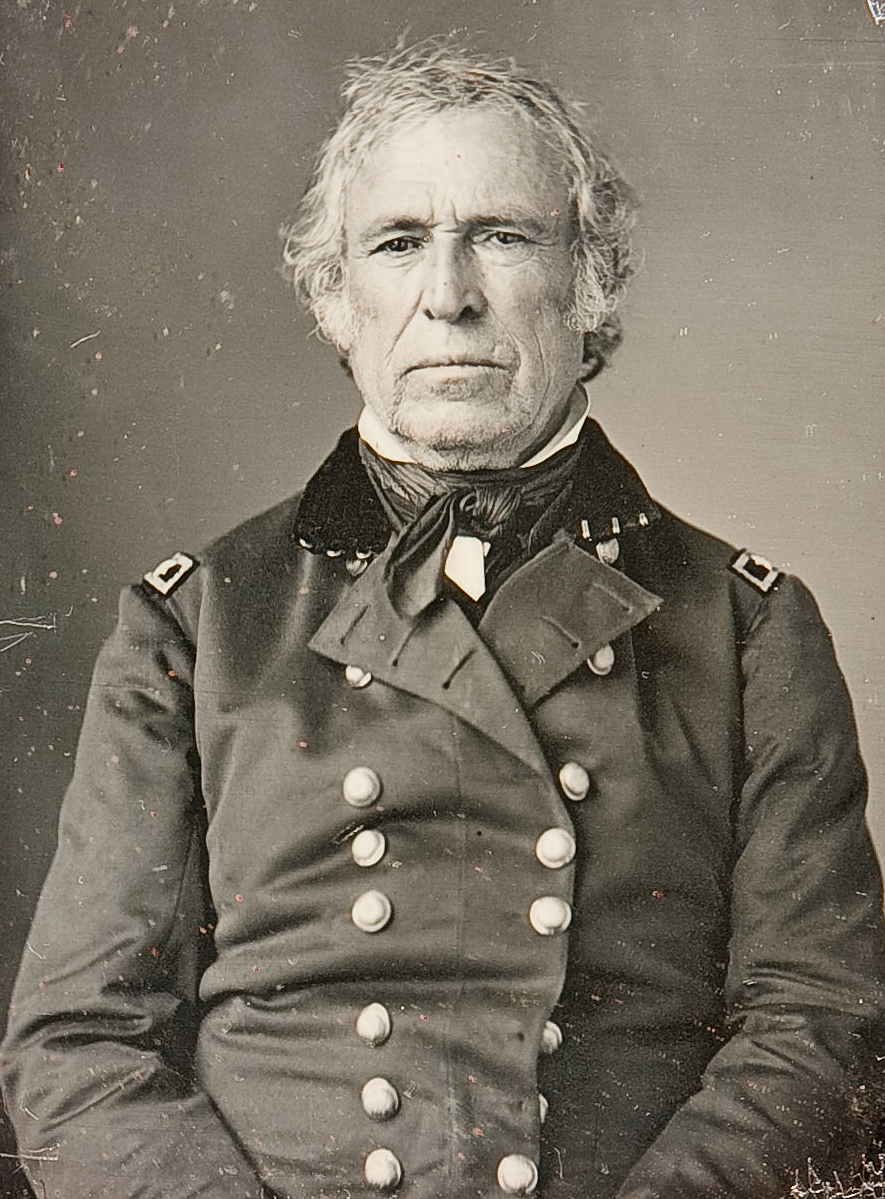All of the land that Mexico owned north of the Rio Grande River was lost by them after the Mexican War, and with the signing of the Treaty of Guadalupe. This included the current day states of Arizona, New Mexico, Utah, Colorado, and California. The US government now believed that they owned the land, however the newly annexed state of Texas believed that they did, and a major battle erupted as to its ownership. Texas was a slave state, so any addition to it, would also be slave. Major General Zachery Taylor who won several prominent battles leading to our victory was a new national war hero. The land dispute became more problematic, as the slavery issue again created sectional differences. The Missouri Compromise Line if extended westward would have been the law of the land, and would have split California, as the territory was preparing for statehood, and didn’t want its southern part to be slave, while its northern part be free. Neither Texas or the United States never really used the newly acquired land, as it was barren and populated by hostile Indian’s, except of course for the massive population explosion of 49’ers…looking for gold. Also, Texas was deeply in debt, as it paid for most of the cost of the war.
 The difference, of course, was crucial within the Senate. The Missouri Compromise drafted years earlier dictated that the land acquired by the Louisiana Purchase north of 36 degrees, 30 minutes be free, while south of it would be slave. The residents of California wanted to join the union as a free state, despite the Missouri Compromise Line, if it was extended westward. The south was furious that President Taylor suggested that California be admitted as a free state. Taylor himself was a southerner and slave owner yet opposed the expansion of slavery, and while President, instructed his son to purchase a plantation in Mississippi, with “80 good hands”. His prime motivation to enter politics was to preserve the union, at all and any cost. Taylor had never even voted in any election, before being chosen by the Whigs as its Presidential candidate, and believed himself an independent as far as party affiliation. Millard Fillmore, a New Yorker, was chosen at the convention to balance the ticket. As Taylor cast his first vote ever in an election to himself, most other American’s did also, and the Taylor-Fillmore ticket won the election, and he became the 12th President.
The difference, of course, was crucial within the Senate. The Missouri Compromise drafted years earlier dictated that the land acquired by the Louisiana Purchase north of 36 degrees, 30 minutes be free, while south of it would be slave. The residents of California wanted to join the union as a free state, despite the Missouri Compromise Line, if it was extended westward. The south was furious that President Taylor suggested that California be admitted as a free state. Taylor himself was a southerner and slave owner yet opposed the expansion of slavery, and while President, instructed his son to purchase a plantation in Mississippi, with “80 good hands”. His prime motivation to enter politics was to preserve the union, at all and any cost. Taylor had never even voted in any election, before being chosen by the Whigs as its Presidential candidate, and believed himself an independent as far as party affiliation. Millard Fillmore, a New Yorker, was chosen at the convention to balance the ticket. As Taylor cast his first vote ever in an election to himself, most other American’s did also, and the Taylor-Fillmore ticket won the election, and he became the 12th President.
While president, any thought of compromise came to a halt, until “The Great Compromiser” himself, Henry Clay became involved. Taylor was involved in the “Galphin Affair”, an issue involving the financial relationship of several of his Cabinet members, and spent a disproportional amount of his time trying to resolve it. He was glad that Clay got involved, yet still remained opposed to his Compromise bills because it allowed and provided for the expansion of slavery, through “popular sovereignty”, and created a Fugitive Slave Bill. Clay carefully crafted a resolution through a series of bills that he hoped would resolve the issue. This conflicted with the Wilmot Proviso, passed by the House, but not in the Senate, which was intended as an amendment to the Treaty of Guadalupe, assuring that all of the newly ceded land would be declared free, not slave. This put the entire compromise in jeopardy. His Vice President, Millard Fillmore, wanted a quick resolve, and was therefore very much in favor of its passage. Clay’s health was failing him, and with Taylor’s opposition, things looked bleak for the future of our nation. The slavery issue, so carefully avoided in the drafting of our Constitution, was now tearing the nation literally in half. The only reference to slavery or slaves was the 3/5 compromise relating to representation within the House, which was based upon population, allowing all “other persons” to be included in the factor as only 3/5 of the white population. Clay drafted two allies within the Senate who helped him guide the bills through for passage; the also ailing southern icon, John C. Calhoun, and the western Stephen Douglas from Illinois. The great Senator Daniel Webster rose on the floor of the Senate, and started perhaps one of its most famous speech’s ever. “I rise, not as a man from Massachusetts, nor as a northerner, but as an American “. Many saw his wisdom, and quickly embraced the bills, and its logic.
Taylor’s opposition, and threat of a veto, plus Clay’s health were the main reasons that the bills were dying a slow death. On July 4th, President Taylor left the White House to speak at the Washington Memorial dedication. The weather was very hot and humid, and seriously conflicted with his heavy wool suit that he wore that day. After the commencement proceeding, he went to several other celebrations, meeting many people and shaking lots of hands before heading home. Once there, he feasted on a large bowl of cherries, some cucumbers, and a pitcher of cold milk. He went to bed early that night feeling woozy and ill, and awoke later vomiting and feeling much worse. His doctor, Thomas Miller, immediately diagnosed dysentery, a stomach ailment created by “dirty water” that was responsible and caused lots of sickness and illness throughout the city, since its inception. Gastroenteritis, was the official medical diagnosis. Miller was the doctor charged with medical malpractice nine years earlier with the confusing, questionable, and quick death of President Harrison. Four days later, President Taylor was dead. With some much at stake now, namely the very existence of the nation, many believed the President was poisoned, as he took a position in opposition to Clay’s compromise, to stall and delay the issue, allowing both the north and south to continue its debating and fighting. He firmly believed that the south wouldn’t succeed from the nation that they helped create, as four of the first five Presidents were from Virginia. All southerners wanted a Fugitive Slave Act, as runaway’s were a constant and troubling matter. During the discussion on the floor, Clay arranged for a “Committee of Thirteen” to digest the issues, and particularly the new Texas border. During the exchange, Vice President Fillmore got into a heated debate with Missouri’s Senator Benton. Henry Foote of Mississippi rose, and drew a pistol on Benton, as Fillmore ruled Benton was out of order. Things on the floor were truly heated and a compromise was nowhere to be seen. After Taylor’s death, all of the bills passed, as Clay had anticipated, after Fillmore put the full weight of the White House behind it. The new President was ready to send Federal troops to resist the Texan’s army, if needed.
 Clay wanted the bills to be voted upon separately, as they could gather majorities if voted individually, rather than as a group, as members could vote up, down, or abstain, on each one.
Clay wanted the bills to be voted upon separately, as they could gather majorities if voted individually, rather than as a group, as members could vote up, down, or abstain, on each one.
First, Texas surrendered its claim to the federal government for all of the ceded land from Mexico, and the Federal government agreed to assume the Texan debt from the war of $ 10,000,000. Next, California was admitted as a free state to the union. The remainder of the new territory would be admitted for statehood based on the concept of “popular sovereignty”. So, the Missouri Compromise Line was now a thing of the past. Furthermore, the slave trade that existed in Washington DC, which ironically was the largest in the country, would cease, and finally a Fugitive Slave Law was enacted, requiring citizens of all states to return slaves to their masters, or face severe penalties. The slaves would not have the right to a trial, and their cases would be heard by local administrator’s, not judge’s, who were paid a federally funded fee for their services. This was a particularly hard pill for the north to assume, as Harriet Beecher Stowe’s novel, “Uncle Tom’s Cabin” was by now required reading for all, as the cruelty of slavery was in print all over the northern and western states.
Had Zachery Taylor not died, the bills never would not have passed, and the slave issue, with the Fugitive Slave Act, and the related Dred Scott decision years later would never have been in the forefront creating the Fort Sumter crisis, and extending the “Southern Conspiracy” starting the great civil war. The lanky statesman with the stovetop hat and beard, from Kentucky, might not have been nominated by the Republican Party, and elected president, to finally resolve the slave issue that had been debated and argued from the time of our nations inception, and the start of our government.
Many believed that Taylor was indeed poisoned, as the timing of his death was too coincidental, and convenient for the compromise supporters. Two Georgia Congressmen, Robert Toombs, and future CSA Vice President, Alexander Stephens were leading the onslaught to remove Taylor, including starting an official censure while Taylor lay dying, for his involvement in the “Galphin Affair”. In 1991 Taylor’s heirs gave their permission to exhume his body for DNA analysis. The resulting report, by Dr. George Nichols, the Kentucky Medical Examiner, indicated arsenic in his body, but not enough to result in his death. No other poisons were tested for, as arsenic was the only toxin that could had survived after 141 years, and his heir’s indicated that no further exhumation’s would be performed on his body.





